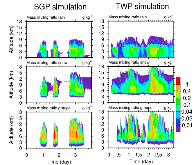Dependence of Vertical Alignment of Cloud and Precipitation Properties on Their Effective Fall Speeds
- Pacific Northwest National Laboratory Richland WA USA
- Brookhaven National Laboratory Upton NY USA
- Department of Mathematical SciencesUniversity of Wisconsin–Milwaukee Milwaukee WI USA
- Centre for Australian Weather and Climate Research Melbourne Victoria Australia
- Earth System Research LaboratoryNOAA Boulder CO USA
The vertical structure of clouds unresolved in large-scale weather prediction and climate models is controlled by an overlap assumption. When a binary representation (cloud or no cloud) of subgrid horizontal variability is replaced by a probability density function (PDF) treatment of cloud-related variables, a cloud occurrence overlap needs to be replaced by a PDF overlap. The PDF overlap can be quantified by a correlation length scale, z0, indicating how rapidly rank correlation of distributions at two levels diminishes with increasing level separation. In this study, we show that z0 varies widely for different properties (e.g., number and mass mixing ratios) and different hydrometeor types (cloud liquid and ice, rain, snow, and graupel) and that corresponding fall speed, Vf, is the primary factor controlling the degree of their vertical alignment, with vertical shear of the horizontal wind playing a smaller role. Linear and power law parametric relationships between z0 and Vf are derived using cloud-resolving simulations of convection under midlatitude continental and tropical oceanic conditions, as well as observations from vertically pointing dual-frequency radar profilers near Darwin, Australia. The functional form of z0-Vf relationship is further examined using simple conceptual models that link variability in horizontal and vertical directions and provide insights into the role of Vf and wind shear. Being based on a physical property (i.e., fall speed) of hydrometeors rather than artificially defined and model-specific hydrometeor types, the proposed parameterization of vertical PDF overlap can be applied to a wide range of microphysics treatments in regional and global models.
- Research Organization:
- Brookhaven National Laboratory (BNL), Upton, NY (United States); Pacific Northwest National Laboratory (PNNL), Richland, WA (United States)
- Sponsoring Organization:
- USDOE Office of Science (SC), Biological and Environmental Research (BER)
- Grant/Contract Number:
- AC06‐76RL01830; SC0016287; SC0012704; AC05-76RL01830
- OSTI ID:
- 1494968
- Alternate ID(s):
- OSTI ID: 1494970; OSTI ID: 1506630; OSTI ID: 1517229
- Report Number(s):
- BNL-211521-2019-JAAM; PNNL-SA-140512
- Journal Information:
- Journal of Geophysical Research: Atmospheres, Journal Name: Journal of Geophysical Research: Atmospheres Vol. 124 Journal Issue: 4; ISSN 2169-897X
- Publisher:
- American Geophysical UnionCopyright Statement
- Country of Publication:
- United States
- Language:
- English
Web of Science
Similar Records
Parameterizations of Cloud Microphysics and Indirect Aerosol Effects
A PDF-Based Parameterization of Subgrid-Scale Hydrometeor Transport in Deep Convection











